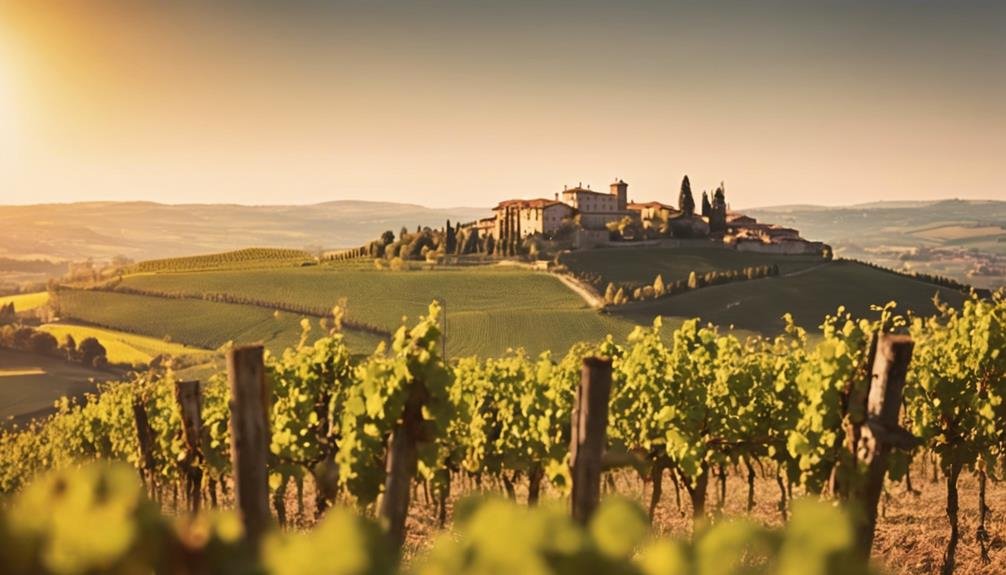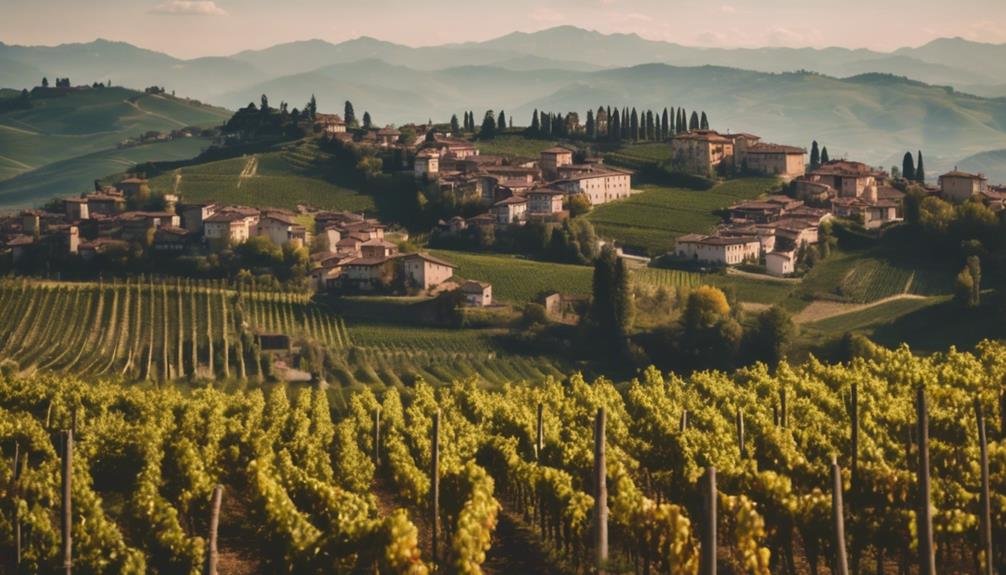Barolo and Barbaresco stand out as exquisite Nebbiolo wines from Italy. Barolo, known as the epitome, boasts raspberry, cherry, and truffle notes, aging for 18 months. Barbaresco, embodying elegance, offers strawberry and rose flavors, requiring 26 months of aging. Roero Nebbiolo, a hidden gem, impresses with sweet fruit flavors and 32 months aging. Discover diverse Nebbiolo expressions from lesser-known regions like Boca and Bramaterra. Each region reflects unique terroirs shaping the wine. Explore the subtle nuances and hidden delights of Italian Nebbiolo beyond Barolo and Barbaresco, revealing a rich tapestry of flavors and landscapes to delve into further.
Barolo: King of Nebbiolo Wines
Heralded as the epitome of Nebbiolo wines, Barolo stands as the undisputed king among its peers in the world of Italian winemaking. Barolo wines age for at least 18 months in the barrel, showcasing bold flavors of raspberry, red cherry, roses, cocoa, anise, and truffles. These wines are known for their pale garnet color, rigid tannins, and high alcohol content.
Barolo Riserva wines, aged for a minimum of five years, offer even more complexity. When considering Nebbiolo pairings, Barolo complements rich, flavorful dishes like truffle risotto, braised meats, and aged cheeses. Its ability to age gracefully for decades makes it a favorite among collectors and enthusiasts alike, embodying the essence of Italian winemaking tradition and excellence.
Barbaresco: Elegance in a Glass
Barbaresco, a distinguished Nebbiolo wine, embodies elegance and finesse in every glass poured, offering a mesmerizing expression of the renowned grape varietal. This wine is elegance personified, with delicate flavors that captivate the senses. Barbaresco, like its counterpart Barolo, hails from the Piedmont region of Italy, showcasing the beauty of Nebbiolo in a slightly lighter and more approachable manner. Below is a comparison table highlighting key characteristics of Barbaresco:
| Aspect | Barbaresco |
|---|---|
| Tannins | Less prominent than Barolo |
| Flavors | Strawberry, raspberry, roses |
| Aging Requirement | 26 months, including 9 in barrel |
Roero: Hidden Nebbiolo Gem

Nestled between the renowned Barolo and Barbaresco regions in Piedmont, Roero quietly shines as a hidden gem showcasing exceptional Nebbiolo wines. Roero's affordability makes it an attractive option for those seeking high-quality Nebbiolo without the hefty price tag commonly associated with Barolo and Barbaresco.
The region's distinct terroir adds to the allure of Roero wines, offering a unique expression of Nebbiolo characterized by intense structure akin to Barolo, yet with sweet fruit flavors reminiscent of Barbaresco. Roero Riserva wines, aged for a minimum of 32 months, including six months in the barrel, exemplify the region's commitment to producing Nebbiolo wines of exceptional quality.
Despite being often overlooked, Roero stands out as a hidden treasure for Nebbiolo enthusiasts looking for value and distinctive terroir.
Nebbiolo Beyond Barolo and Barbaresco
Exploring Nebbiolo wines beyond the renowned regions of Barolo and Barbaresco reveals a diverse spectrum of expressions from lesser-known appellations in Northern Italy. Nebbiolo diversity shines through in regions like Boca, known for earthy and rustic wines with high acidity, and Bramaterra, offering lighter profiles with fresh red berry and rose aromas.
Canavese presents floral and earthy notes with robust tannins and hints of licorice, while Carema delivers fruity and floral expressions. Lessona stands out for its elegant wines, boasting perfumed floral notes and high acidity. Each region showcases unique regional expressions of Nebbiolo, highlighting the grape's versatility.
Understanding Nebbiolo aging is essential, with ideal timelines varying across regions to reveal the full potential of these distinctive wines.
Exploring Unique Nebbiolo Terroirs

Delving into the distinct terroirs of lesser-known Nebbiolo regions in Northern Italy reveals a tapestry of diverse expressions and unique characteristics that showcase the grape's adaptability and regional nuances. Nebbiolo soil types greatly influence the flavors and structure of the wines produced, emphasizing the importance of terroir influence in winemaking. Here is a comparison of some unique Nebbiolo terroirs in Northern Italy:
| Region | Soil Type |
|---|---|
| Boca | Earthy and rustic |
| Bramaterra | Light with red berry aromas |
| Canavese | Floral and earthy |
Each of these regions offers a different perspective on Nebbiolo, reflecting the impact of soil composition on the final wine.
Frequently Asked Questions
How Do You Properly Decant a Young Barolo Wine?
Decanting a young Barolo wine allows it to breathe, enhancing its aromas and flavors. To properly decant, pour the wine slowly into a decanter to separate it from sediment, facilitating aeration, which benefits the wine's development.
What Food Pairings Work Best With Aged Barbaresco Wines?
In the domain of aged Barbaresco wines, consider exquisite truffle pairings to complement their evolving flavors. Select aged cheeses to harmonize with the wine's nuanced profile. Embrace the art of wine aging.
What Makes Roero Nebbiolo Wines a Hidden Gem?
Roero Nebbiolo exploration reveals hidden gem status through intense structure akin to Barolo but with approachable pricing. Sweet fruit flavors reminiscent of Barbaresco, coupled with a notable aging potential, make Roero wines a delightful discovery for Nebbiolo enthusiasts seeking quality and value.
Are There Any Unique Winemaking Techniques Used in Boca Nebbiolo Production?
In Boca Nebbiolo production, winemakers employ a blend of ancient techniques and modern innovations. These methods contribute to the unique character of the wine, which is known for its earthy and rustic qualities, high acidity, and firm tannins.
How Do the Nebbiolo Wines From Carema Differ From Those of Barolo and Barbaresco?
Carema Nebbiolo wines, crafted through traditional methods, exhibit floral and fruity notes distinct from Barolo and Barbaresco. Terroir plays a pivotal role in Carema's elegant wines, showcasing high acidity and perfumed floral characteristics, setting them apart from their renowned counterparts.
Conclusion
To sum up, delving into the diverse expressions of Nebbiolo wines beyond Barolo and Barbaresco is like discovering hidden treasures in a vast vineyard. Each sip unveils a unique terroir and nuanced characteristics that highlight the true essence of this noble grape varietal.
From the bold tannins of Barolo to the elegant notes of Barbaresco and the hidden gem of Roero, Nebbiolo wines offer a sensory journey that is both enlightening and delightful.
Cheers to uncovering Italy's vinous treasures!